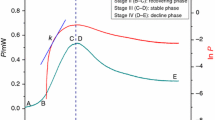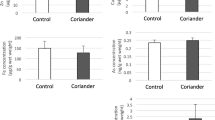Abstract
The fact that mitochondria still have metabolic activity and can live for a week with appropriate nutrients after isolated from the rat liver provides us a useful means to investigate the metabolic process of mitochondria influenced by chemicals. Using the TAM air isothermal microcalorimeter, the HP-time curves of the metabolic activity of mitochondria were measured. The effects of five Aconitum L. plants, Radix Aconiti Lateralis Preparata (RALP), Radix Aconiti (RA), Radix Aconiti Kusnezoffii (RAK), Radix Aconiti Brachypodi (RAB), and Radix Aconiti Singularis (RAS) on the metabolic activity of mitochondria were investigated, respectively. The quantitative information, such as k, Q, P max, T max, T lag, and P av obtained from the HP-time curves, were accumulated for analysis. With the help of PCA method, P av was selected as the standard for comparing the different effects of five Aconitum L. plants on metabolic activity of mitochondria. The potential sequence of efficiency was RAS > RAK > RAB > RA > RALP, and the EC50 were separately 1.43, 2.31, 1.10, 1.61, and 2.56 mg mL−1. The results demonstrated that the five Aconitum L. plants had different bioeffects on the mitochondria metabolism. Meanwhile, this study indicated that microcalorimetry was a powerful tool to evaluate the drugs’ efficiency on living system, providing some useful references for the application of five Aconitum L. plants in practice.





Similar content being viewed by others
Abbreviations
- CHM:
-
Chinese herb medicine
- RALP:
-
Radix Aconiti Lateralis Preparata
- RA:
-
Radix Aconiti
- RAK:
-
Radix Aconiti Kusnezoffii
- RAB:
-
Radix Aconiti Brachypodi
- RAS:
-
Radix Aconiti Singularis
- PCA:
-
Principal component analysis
References
Kong WJ, Zhao YL, **ao XH, Wang JB, Li HB, Li ZL, ** C, Liu Y. Spectrum-effect relationships between ultra-performance liquid chromatography fingerprints and anti-bacterial activities of Rhizoma Coptidis. Anal Chim Acta. 2009;634:279–85.
Fu LG. Higher plants of Chinese (Volume III). Qingdao: Qingdao Publishing House; 2000.
**ao PG, Wang FP, Gao F, Yan LP, Chen DL, Liu Y. A pharmacophylogenetic study of Aconitum L. (Ranunculaceae) from China. Acta Phytotaxon Sinica. 2006;44:1.
Bisset NG. Arrow poisons in China, Part II. Aconitum—botany, chemistry, and pharmacology. J Ethnopharmacol. 1981;4(3):247–360.
Sharma E, Gaur A. Aconitum balfourii Stapf: a rare medicinal herb from Himalayan Alpine. J Med Plants Res. 2012;6:3810–7.
Sheng L. The relationship between Herb’s 4 Natures and 5 Flavors. Mod J Integr TCM West Med. 2004;11:2804–6.
Giordano J, Boatwright D, Stapleton S, Huff L. Blending the boundaries: steps toward an integration of complementary and alternative medicine into mainstream practice. J Altern Complement Med. 2002;8(6):897–906.
Lozano F. Basic theories of traditional Chinese medicine. Acupuncture for pain management. New York: Springer; 2014. p. 13–43.
Wang MQ, Yan SL, Li WH, Wu B, Feng R, Liu BG. A study on Chinese herb of cold and hot on SD Rats. J Zhejiang Coll TCM. 2002;6:1417–21.
Yu MH, Zhou HZ, **ao XH, Liu TS, Yuan HL, Zhao YL, Gao XS. Advances and prospects of four properties of Chinese traditional medicine. Chin J Basic Med TCM. 2001;8:61–4.
Abebe W. Herbal medication: potential for adverse interactions with analgesic drugs. J Clin Pharm Ther. 2002;27(6):391–401.
Gao N, Yang Y, Wang SJ, Rong R, Lin JJ, Wang XP. Determination of contents of adenine nucleotides and energy charge in rat liver tissue treated with Aconite roots by HPLC. Chin J Exp Tradit Med Formulae. 2010;15:057.
Zhou C, Wang J, Zhang X, Zhao Y, **a X, Zhao H, Ren Y, **ao X. Investigation of the differences between the “COLD” and “HOT” nature of Coptis Chinensis Franch and its processed materials based on animal’s temperature tropism. Sci China Ser C Life Sci. 2009;52(11):1073–80.
Rhyu DY, Kang KS, Sekiya M, Yokozawa T. Antioxidant effect of Wen-Pi-Tang and its component crude drugs on oxidative stress. Am J Chin Med. 2007;35(01):127–37.
Huang L, Peng S, Zhang S, Hu Q, Yu R, Liu H, Sun J. Hepatic energy metabolism on rats by six traditional Chinese medicines with hot property. China J Chin Mater Med. 2010;35(11):1470–3.
Yan D, **ao XH, ** C, Dong XP. Challenge and development of quality administration mode of Chinese materia medica. Chin Tradit Herb Drugs. 2006;37(6):806.
Shen XS, ** MH, Zhao CX, Tan XQ, Liu HF, Qin XL, Qiu ZP, Liu Y. Microcalorimetric study of the effect of artesunate on the growth metabolism of mitochondria isolated from rat liver. J Therm Anal Calorim. 2013;3(111):1947–52.
Zhao YL, Wei SS, Wang JB, Zhang P, Li RS, **ao XH. Microcalorimetry coupled with principal component analysis for comparing the effects of two Panax species on mice splenic lymphocytes. J Therm Anal Calorim. 2011;111(3):1169–74.
Liu TT, Zhao YL, Wang JB, Zhou X, Sun ZY, Zheng QF, Li RS, Zhang P, Li JY, Song XA, **ao XH. Action of crude Radix Aconiti Lateralis (Fuzi) and its processed products on splenic lymphocytes growth investigated by microcalorimetry. Thermochim Acta. 2013;571:1–7.
Zhao YL, Wang JB, Zhang P, Li RS, **ao XH. Microcalorimetric study of the opposing effects of ginsenosides Rg1 and Rb 1 on the growth of mice splenic lymphocytes. J Therm Anal Calorim. 2010;102:286–93.
Zheng QF, Zhao YL, Wang JB, Liu TT, Zhang B, Gong M, Li JY, Liu HH, Han B, Zhang YM, Song XA, Li YG, **ao XH. Spectrum-effect relationships between UPLC fingerprints and bioactivities of crude secondary roots of Aconitum carmichaelii Debeaux (Fuzi) and its three processed products on mitochondrial growth coupled with canonical correlation analysis. J Ethnopharmacol. 2014;153(3):615–23.
Gaisford S. Isothermal microcalorimetry for quantifying amorphous content in processed pharmaceuticals. Adv Drug Deliv Rev. 2012;64(5):431–9.
Ren YS, Yan D, Zhang P, Li HB, Feng X, Zhang YM, Luo Y, **ao XH. Hemagglutination activity of radix isatidis detected by microcalorimetry. Acta pharma Sinica. 2010;45(8):1028.
Braissant O, Wirz D, Göpfert B, Daniels A. “The heat is on”: rapid microcalorimetric detection of mycobacteria in culture. Tuberculosis. 2010;90(1):57–9.
Kabanova N, Stulova I, Vilu R. Microcalorimetric study of the growth of bacterial colonies of Lactococcus lactis IL1403 in agar gels. Food Microbiol. 2012;29(1):67–79.
Kong WJ, Zhao YL, **ao XH, Li ZL, Ren YS. Action of palmatine on Tetrahymena thermophile BF5 growth investigated by microcalorimetry. J Hazard Mater. 2009;168(2):609–13.
Todinova S, Krumova S, Gartcheva L, Robeerst C, Taneva SG. Microcalorimetry of blood serum proteome: a modified interaction network in the multiple myeloma case. Anal Chem. 2011;83(20):7992–8.
Zhao HP, Zhao YL, Wang JB, Li HB, Ren YS, Zhou CP, Yan D, **ao XH. Expression of the difference between the Cold (Han) and Hot (Re) natures of traditional Chinese medicines (Strobal and Rhubarb) based on the cold/hot plate differentiating assay. Sci China Ser C Life Sci. 2009;52(12):1192–7.
Wadsö I. Isothermal microcalorimetry in applied biology. Thermochim Acta. 2002;394(1):305–11.
Cao JL, Li ZL, Qiang F, **ao XH. Microcaloritry study of the influence of different extract fraction from Radix ginseng on the liver mitochondria of rat. Chin J Hosp Pharm. 2007;27(9):1187.
Wang XQ, **e CL, Qu SS, Zhou ZJ. Microcalorimetric study of mitochondrial metabolism. Thermochim Acta. 1991;176:69–74.
Sun ZY, Zhao YL, Liu TT, Sun XJ, Li RS, Zhang P, **ao XH. Spectrum-effect relationships between UPLC fingerprints and bioactivities of five Aconitum L. plants. Thermochim Acta. 2013;558:61–6.
Zhu JC, Li CH, Liu Y, Zhang ZH, Hou AX, Qu SS. A microcalorimetric study of the action of mercuric chloride on the metabolism of mitochondria isolated from Cyprinus carpio liver tissue. J Therm Anal Calorim. 2006;83(1):181–6.
Jackson JE. A user’s guide to principal components. New York: Wiley; 2005.
Pierce KM, Hope JL, Johnson KJ, Wright BW, Synovec RE. Classification of gasoline data obtained by gas chromatography using a piecewise alignment algorithm combined with feature selection and principal component analysis. J Chromatogr A. 2005;1096(1):101–10.
Pickett CB, Cascarano J, Johnson R. Oxidative phosphorylation in rat liver mitochondria isolated by rate zonal centrifugation: examination of Ficoll gradients and subpopulations of Mitochondria. J Bioenerg Biomembr. 1977;9(4):271–82.
Anyasor G, Ajayi E, Saliu J, Ajagbonna O, Olorunsogo O. Artesunate opens mitochondrial membrane permeability transition pore. Ann Trop Med Pub Health. 2009;2(2):37.
Manoharan I, Boopathy R. Diisopropylfluorophosphate-sensitive aryl acylamidase activity of fatty acid free human serum albumin. Arch Biochem Biophys. 2006;452(2):186–8.
Zhao RM, Liu Y, **e ZX, Shen P, Qu SS. Microcalorimetric study of the action of Ce(III) ions on the growth of E. coli. Biol Trace Elem Res. 2002;86(2):167–75.
McGill R, Tukey JW, Larsen WA. Variations of Box Plots. Am Stat. 1978;32(1):12–6.
Abebe W. Herbal medication: potential for adverse interactions with analgesic drugs. J Clin Pharm Ther. 2002;27:391–401.
Wallace DC. Mitochondrial genetics: a paradigm for ageing and degenerative disease. Science. 1992;256:628–32.
Acknowledgements
We are grateful for the support of the National Natural Sciences Foundation (No. 81173571), National Basic Research Program of China (No. 2007CB512607), and the Major Projects of the National Science and Technology (2012ZX10005010-002-002).
Author information
Authors and Affiliations
Corresponding author
Additional information
Quanfu Zheng, Ruisheng Li have contribute equally to this study/work and should be considered co-first authors.
Rights and permissions
About this article
Cite this article
Zheng, Q., Li, R., Li, C. et al. Microcalorimetric investigation of five Aconitum L. plants on the metabolic activity of mitochondria isolated from rat liver. J Therm Anal Calorim 120, 335–344 (2015). https://doi.org/10.1007/s10973-014-4160-1
Received:
Accepted:
Published:
Issue Date:
DOI: https://doi.org/10.1007/s10973-014-4160-1




